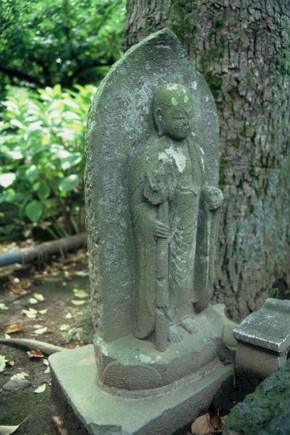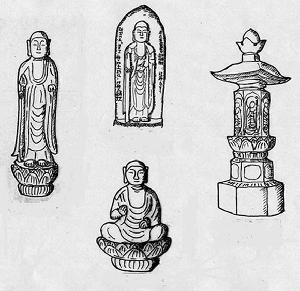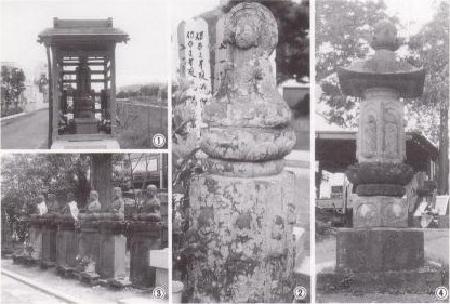Update date: June 27, 2017

Jizo Bodhisattva Pagoda at Jorakuji Temple (Inagi City designated cultural property)
Faith in Jizo Bodhisattva
Jizo Bodhisattva It is said that worship began in the Nara period. Latter Days of the Law It spread during the Heian period, when the Shinto religion became popular, and became a popular object of worship for the common people. This faith is believed to be a way to avoid suffering in this world and the afterlife. Worldly Benefits It is the faith of All living beings It is believed to have great power to save people and to represent the blessings of the earth.
Stone Buddha statues began to be made at the end of the Heian period, and in the Edo period they became widely established in rural areas as objects of worship for the common people, and were made in large numbers. Jizo Bodhisattva Tower These are the most numerous and can truly be said to be representative stone Buddha statues of the early modern period. Monk form On your left Jewel (A jewel that grants wishes) in his right hand Staff It is common to see Jizo holding a walking stick (a walking stick carried by monks), and he has become a familiar and universal object of Jizo worship.
Jizo Bodhisattva Pagoda in Inagi City
There are currently 40 such facilities in Inagi City. Jizo Bodhisattva Tower There are. When you look at the time it was built, Kanbun From 1664 Ansei They span a period of about 200 years, from 1917 to 1860, with the most being built in the 1700s. They are often found along old roads, in temple grounds, and in cemeteries, but many have been removed from their original locations due to recent development work. In terms of geographical distribution, they are mostly concentrated in Yanoguchi, Higashinagumanuma, and Sakahama.
In the city Jizo Bodhisattva Tower Let's take a look at the form and content of the form. Round Carving Rino Statue 22 examples of carved in the round Seated statue 7 cases, Boat-shaped halo of Relief the law of nature Statue 9 cases, Six-sided banner They can be divided into five types: one example of a standing relief statue, one example of a seated statue combined with a standing relief statue, and one example of a seated statue combined with a standing relief statue. Six Jizo Statues There are nine of these in the form of a set. Looking at the relationship between the creator and faith, the creator Nembutsu group There are 16 cases where the original was erected by a single person, 9 cases where it was erected by multiple people, 6 cases where it was erected by an individual, and 9 cases where it is unknown. This shows that many of the structures were erected by members of Buddhist chanting groups that were practiced in each region. It is also noteworthy that women are prominent among the builders. Women's Buddhist chanting group "or" Somura maid " indicates that the deity was particularly popular among women. There are also examples of the belief in Jizo Bodhisattva being combined with other beliefs. Koushin Memorial service , Scripture Memorial service, Return to country Memorial service, bridge Memorial services etc. Inscription As can be seen, he had connections with a variety of faiths.

Form of Jizo Bodhisattva Tower
Regional distribution
| district |
quantity |
| Yanoguchi |
10 |
| Oshidate |
1 |
| Higashinaganuma |
8 |
| Daimaru |
3 |
| 100 villages |
5 |
| Sakahama |
8 |
| Hirao |
5 |
| total |
40 |
A typical Jizo Bodhisattva tower
Next, we will introduce some of the city's most representative Jizo Bodhisattva towers.
First, the photo at the top of the page is in the grounds of Jorakuji Temple. Kanbun Built in 1664, this is the oldest Jizo Bodhisattva pagoda in the city. Shimonita, Naganuma Village It was built by people from Ten people who pray to the Buddha and seven people who pray to the god of the fire From the inscription, it can be seen that the Koushin It is clear that it was also connected to religious faith. It is also the oldest Koshin tower. Blue-faced Vajra but Emperor This is an old style stone Buddha statue from before it became common.
The photo below is of Higashinaganuma. Parapet bridge The " Life extension Jizo This Jizo Bodhisattva tower is called "Kisaragi Bodhisattva Tower" and was given a unique name due to the faith of many local people. Yabe Jizo There are examples with names such as " Engakuji Temple It stands in the precincts and features a carved seated statue and Base stone Relief of Six Jizo Statues This is a rare example of a combination of the six Jizo statues. The six realms of reincarnation The purpose of the statues is to save the deceased who are suffering in the world of suffering. Six Jizo statues It stands at the entrance to the old approach to Koshoji Temple.

Jizo Bodhisattva Pagoda in the city










